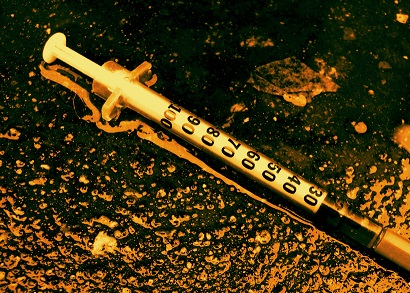
What is krokodil? Krokodil, the street name for Desomorphine, is a homemade injectable opiate drug. Krokodil is common in Russia and the Ukraine, with estimates of 100,000 and 20,000 people respectively reported using the drug in 2011 (Christensen, 2013). The drug krokodil is developed by combining the painkiller codeine with commonly available chemicals that include iodine, kitchen and bathroom cleaners, hydrochloric acid, red phosphorous from matchbooks and solvents such as paint thinner and gasoline (Christensen, 2013). These ingredients are high in toxicity, and when injected intravenously causes severe tissue damage.
Krokodil garners the name due to the reported green and/or black discolored scaly skin changes like a crocodile (Bekiempi, 2013 and Christensen, 2013). The DEA reported that the long-term effects can include damaged blood vessels, thrombosis and damaged soft tissues surrounding the injection sites. These conditions can lead to gangrene (Behm, 2013). According to reports, the average lifespan of a krokodil user after starting on the drug is around 2.5 years (Bekiempi, 2013).
Jean-Paul C. Grunda, Alisher Latypovc, and Magdalena Harris (2013) found in their research study:
Localized damage
• Thrombosis of the major vessels and erosive bleeding
• Large open ulcers, phlebitis and gangrene at and around injection sites
• Skin and soft tissue infections to the bone
• Limb amputations
• Large scabs on the limbs and elsewhere on the body, pieces of dead skin that come off in one piece
• Veins that ulcer and rot away from the inside, requiring surgical removal of the main veins
Systemic damage
• Pneumonia
• Blood poisoning
• Coronary artery burst
• Meningitis
• Rotting gums resulting in tooth loss
• Bone infection, decayed structure of the jaw and other facial bones
• Sores and ulcers on the forehead and skull
• Gangrenous wounds on various part of the body
• Rotting ears, noses and lips
• Liver and kidney problems
• Death
Neurological damage
• Speech impediments
• Motor skills impairments
• Affected memory and concentration
• Personality changes
Jen Christensen with CNN reported in October 2013 five people were hospitalized in the Chicago suburb of Joliet, Illinois, with symptoms associated with krokodil. Additionally, similar cases have been reported by health care providers in Arizona and Oklahoma (Christensen, 2013) and Columbus, OH (Behm, 2013). The Drug Enforcement Administration has not confirmed these cases are directly associated with krokodil, but has directed law enforcement agencies and medical institutions to report any discovered forms of the drug (Bekiempi, 2013).
To learn more about krokodil, please review the Drug Enforcement Administration's drug fact sheet http://www.deadiversion.usdoj.gov/drug_chem_info/desomorphine.pdf.
Krokodil garners the name due to the reported green and/or black discolored scaly skin changes like a crocodile (Bekiempi, 2013 and Christensen, 2013). The DEA reported that the long-term effects can include damaged blood vessels, thrombosis and damaged soft tissues surrounding the injection sites. These conditions can lead to gangrene (Behm, 2013). According to reports, the average lifespan of a krokodil user after starting on the drug is around 2.5 years (Bekiempi, 2013).
Jean-Paul C. Grunda, Alisher Latypovc, and Magdalena Harris (2013) found in their research study:
Localized damage
• Thrombosis of the major vessels and erosive bleeding
• Large open ulcers, phlebitis and gangrene at and around injection sites
• Skin and soft tissue infections to the bone
• Limb amputations
• Large scabs on the limbs and elsewhere on the body, pieces of dead skin that come off in one piece
• Veins that ulcer and rot away from the inside, requiring surgical removal of the main veins
Systemic damage
• Pneumonia
• Blood poisoning
• Coronary artery burst
• Meningitis
• Rotting gums resulting in tooth loss
• Bone infection, decayed structure of the jaw and other facial bones
• Sores and ulcers on the forehead and skull
• Gangrenous wounds on various part of the body
• Rotting ears, noses and lips
• Liver and kidney problems
• Death
Neurological damage
• Speech impediments
• Motor skills impairments
• Affected memory and concentration
• Personality changes
Jen Christensen with CNN reported in October 2013 five people were hospitalized in the Chicago suburb of Joliet, Illinois, with symptoms associated with krokodil. Additionally, similar cases have been reported by health care providers in Arizona and Oklahoma (Christensen, 2013) and Columbus, OH (Behm, 2013). The Drug Enforcement Administration has not confirmed these cases are directly associated with krokodil, but has directed law enforcement agencies and medical institutions to report any discovered forms of the drug (Bekiempi, 2013).
To learn more about krokodil, please review the Drug Enforcement Administration's drug fact sheet http://www.deadiversion.usdoj.gov/drug_chem_info/desomorphine.pdf.
See then that you walk circumspectly, not as fools but as wise, redeeming the time, because the days are evil.Therefore do not be unwise, but understand what the will of the Lord is. And do not be drunk with wine, in which is dissipation; but be filled with the Spirit.
Ephesians 5:14-18 NKJV
Sources:
1. Behm, J. (2013, November 10). Krokodil drug concerns in Lorain County. The Morning Journal, Retrieved from http://www.morningjournal.com/general-news/20131110/krokodil-drug-concerns-in-lorain-county
2. Bekiempism, V. (2013, October 21). Why You Don't Need to Worry About 'Flesh-Eating' Drug Krokodil. Newsweek. Retrieved from http://www.newsweek.com/why-you-do-not-need-worry-about-flesh-eating-drug-krokodil-613
3. Christensen, J. (2013, October 18). Flesh-eating 'zombie' drug 'kills you from the inside out'. CNN. Retrieved from http://www.cnn.com/2013/10/16/health/krokodil-zombie-drug/
4. Grunda, J.C., Latypovc, A., and Harris, M. (2013). Breaking worse: The emergence of krokodil and excessive injuries among people who inject drugs in Eurasia. International Journal of Drug Policy. Retrieved from http://www.idhdp.com/media/41793/inj_damage_from_krokodil_in_eurasia.pdf
1. Behm, J. (2013, November 10). Krokodil drug concerns in Lorain County. The Morning Journal, Retrieved from http://www.morningjournal.com/general-news/20131110/krokodil-drug-concerns-in-lorain-county
2. Bekiempism, V. (2013, October 21). Why You Don't Need to Worry About 'Flesh-Eating' Drug Krokodil. Newsweek. Retrieved from http://www.newsweek.com/why-you-do-not-need-worry-about-flesh-eating-drug-krokodil-613
3. Christensen, J. (2013, October 18). Flesh-eating 'zombie' drug 'kills you from the inside out'. CNN. Retrieved from http://www.cnn.com/2013/10/16/health/krokodil-zombie-drug/
4. Grunda, J.C., Latypovc, A., and Harris, M. (2013). Breaking worse: The emergence of krokodil and excessive injuries among people who inject drugs in Eurasia. International Journal of Drug Policy. Retrieved from http://www.idhdp.com/media/41793/inj_damage_from_krokodil_in_eurasia.pdf
No comments:
Post a Comment